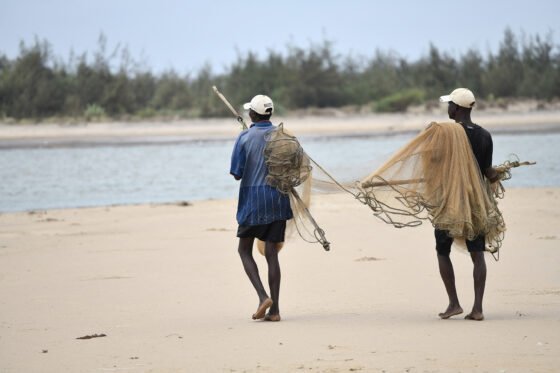
On the banks of Kenya’s Sabaki River, locals are working to bring this estuary, scarred by years of over-exploitation, back to life. Tree by tree, the volunteers recreate a coastal mangrove, an ecosystem that is essential for environmental balance.
Along a riverbank scarred by deforestation, Joseph Mwandge Mangi points to a lone mangrove tree, a species once abundant in the estuary where the mighty Sabaki River meets the Indian Ocean: “This is the last one. There’s no one left”† For the residents of this area of Kenya’s east coast, this miracle tree is a reminder of the work that must be done to restore the natural balance broken by decades of over-exploitation.
For generations, local communities have used the natural resources that the Sabaki offers: timber, firewood, fresh water, seafood, fertile farmland, plants for traditional medicines…
This coastal wetland has many benefits in light of climate change: carbon storage, water pollution filtering, natural protection against extreme weather and sea level rise†
But years of uncontrolled exploitation have caused terrible damage to the mangroves, mudflats, freshwater pools and sand dunes along the mouth of Kenya’s second longest river.
A changed landscape
Mangrove wood – sustainably used for centuries to build traditional Swahili homes – is heavily used to support fast-growing cities, such as the nearby seaside town of Malindi.
For fishing, the inhabitants used mosquito nets that trapped even the smallest sea creatures.
“The landscape has changed. We then had a huge forest with elephants and monkeys”said 68-year-old community leader Francis Nyale, standing in the middle of a clearing of gnarled mangrove stumps.
A little further downstream, where the brown waters of the Sabaki meet the blue waves of the ocean, a team of volunteers is planting young mangrove trees along the coast. For several years now, residents have chosen to bring the damaged estuary to life tree by tree. They have planted tens of thousands to revive forests, said Francis Kagema, the regional coordinator of the environmental protection group Nature Kenya. And these efforts are showing early signs of success.
A healing ecosystem
Francis Kagema, crouched in the middle of a forest, shows clusters of small green shoots sprouting from the dark ground, evidence of a natural regeneration, of a healing ecosystem.
“When it comes to mangroves, their ability to recover (…) and repopulate their former areas is quite encouraging.”
Francis Kagema, Regional Coordinator of the conservation group Nature Kenya
Mangroves are precious to the planet: their trees can absorb five times more carbon than terrestrial forests and act like a barrier against storms and erosion.
According to the United Nations Environment Program (UNEP), which sponsors the Sabaki Restoration Project, protecting mangroves costs 1,000 times less per kilometer than building dikes.
“Healthy wetlands – crucial to combating climate change, for biodiversity, human health and prosperity – pay far more than they cost”said Leticia Carvalho, UNEP Senior Marine and Freshwater Coordinator.
A lesson in diplomacy
In addition to the environmental benefits, they also provide economic benefits. According to UNEP, one hectare of mangrove can yield the equivalent of: $33,000 to $57,000 per year (30,000 to 52,000 euros) in economic services.
In Sabaki, local guides supplement their income by allowing tourists and school groups to observe the hippos and birds that live in the estuary. Efforts are also underway to improve tourist facilities and develop traditional beekeeping.
Convincing the four villages around the estuary of the importance of protecting the environment requires diplomacy, emphasizes Joseph Mwandge Mangi, who heads a community group for the protection of the estuary.
They work with fishermen to get them to abandon unsustainable practices and volunteer foresters, who delight loggers in the estuary, manage internal violations so as not to antagonize the populations.
“We are not taking them to the police. We talk to them. We want them to understand that there is something beneficial in these trees instead of cutting them down.”
Joseph Mwandge Mangi, leader of a community group for the protection of estuaries.
According to Jared Bosire, project manager at an Indian Ocean conservation organization called the Nairobi Convention, the Sabaki community is proving that local approaches to environmental protection are mutually beneficial. “We are hopeful that the lessons learned can be adopted elsewhere”he believes.
More than 80% of the mangroves have already disappeared along the western parts of the Indian Ocean. “If We Don’t Have These Trees”says Mangi, “we are losing our heritage”†
(AFP)